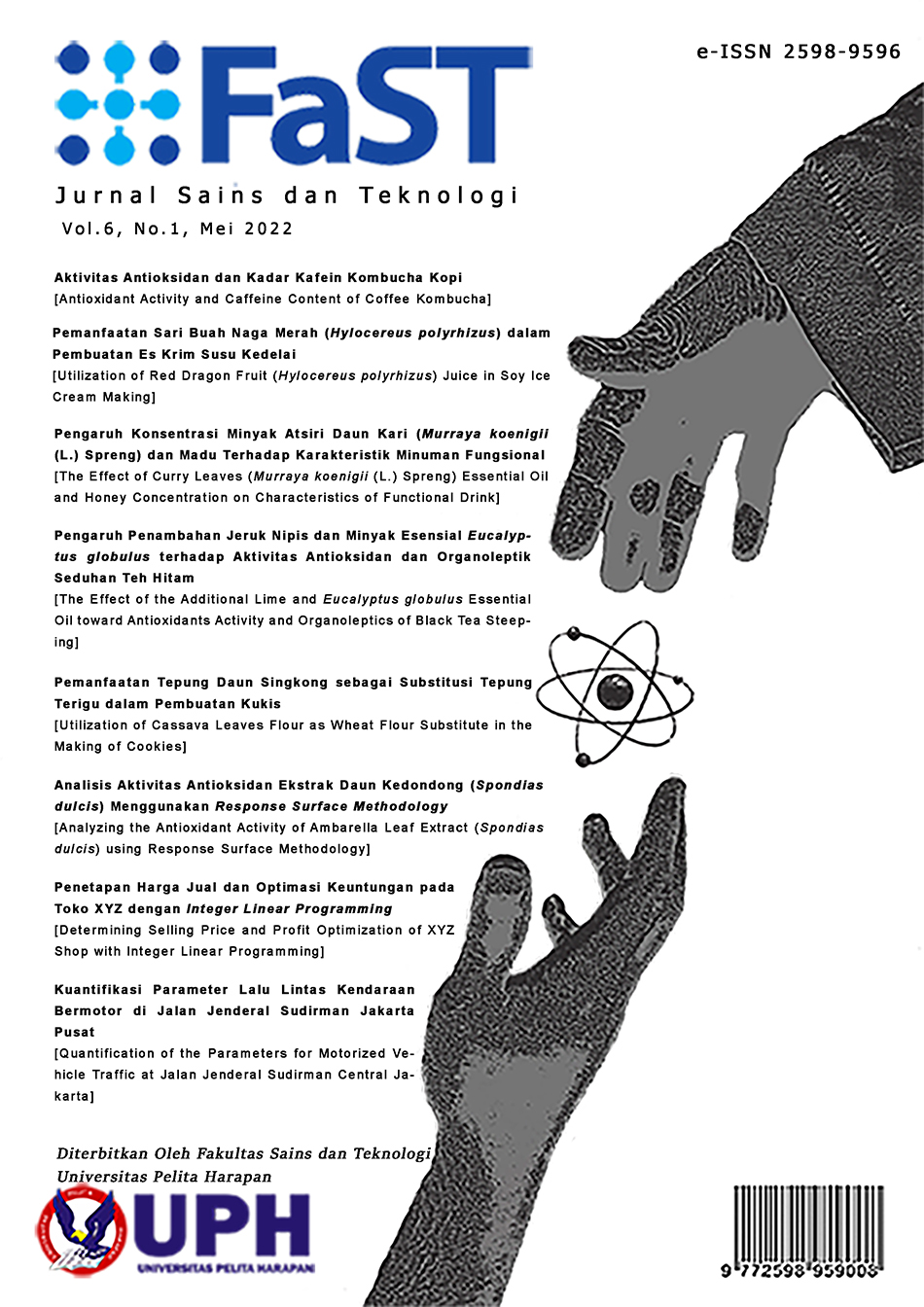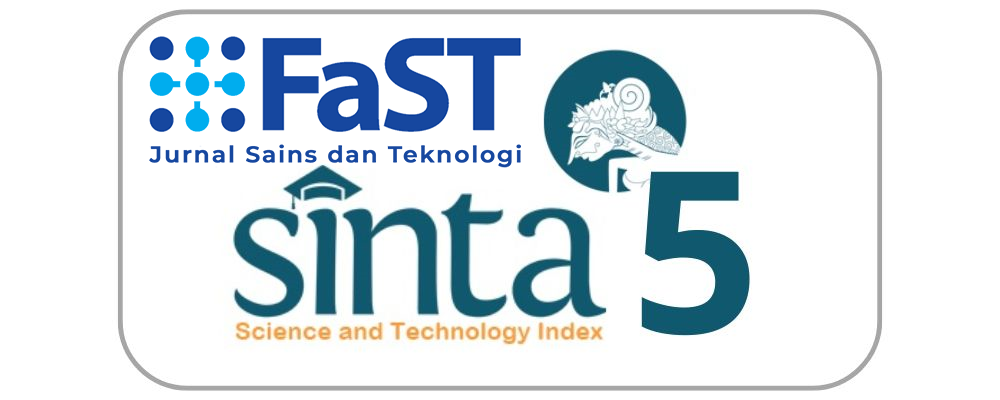Pemanfaatan Sari Buah Naga Merah (Hylocereus polyrhizus) dalam Pembuatan Es Krim Susu Kedelai [Utilization of Red Dragon Fruit (Hylocereus polyrhizus) Juice in Soy Ice Cream Making]
DOI:
https://doi.org/10.19166/jstfast.v6i1.5209Keywords:
antioxidant, CMC, red dragon fruit, soy ice cream, stabilizerAbstract
Red dragon fruit (Hylocereus polyrhizus) contains betalains which can be used as a natural colorant with antioxidant properties. Low acceptance of soy ice cream that is usually caused by beany flavor can be reduced by addition of antioxidant in red dragon fruit juice. This research was aimed to determine the effect of red dragon fruit juice addition and different types and concentration of stabilizers on soy ice cream characteristics. In the first research stage, soy ice cream was made with different red dragon fruit juice concentrations (0%, 5%, 10%, 15% and 20%). Soy ice cream with 20% of red dragon juice addition was chosen because it had IC50 value of 132298 ± 29802 ppm, highest overrun, and best organoleptic acceptance. In the second research stage, soy ice cream was made with different stabilizer types (CMC 0.2%, CMC 0.1%, and k-carrageenan 0.1%, and k-carrageenan 0.2%). Soy ice cream with CMC 0.2% was the selected formulation because it has the highest overrun (36.44 ± 1.58%) and slowest melting time (54.00 ± 0.61 min). The selected soy ice cream contained 61.85% moisture, 0.72% ash, 2.74% fat, 5.65% protein and 29.04% carbohydrate.Bahasa Indonesia Abstract:
Buah naga merah (Hylocereus polyrhizus) mengandung betalain yang dapat digunakan sebagai pewarna alami yang memiliki sifat antioksidan. Penerimaan es krim susu kedelai yang rendah yang biasanya disebabkan oleh aroma langu dapat dikurangi dengan penambahan antioksidan dari sari buah naga. Penelitian ini bertujuan menentukan pengaruh penambahan sari buah merah dan pengaruh jenis dan konsentrasi stabilizer terhadap karakteristik fisik es krim susu kedelai. Pada penelitian tahap pertama, es krim susu kedelai dibuat dengan berbagai konsentrasi sari buah naga (0%, 5%, 10%, 15%, dan 20%). Es krim susu kedelai dengan penambahan 20% sari buah naga merah merupakan formulasi terpilih karena memiliki nilai IC50 sebesar 132298±29802 ppm, overrun tertinggi, dan penerimaan organoleptik terbaik. Pada penelitian tahap kedua, es krim susu kedelai dibuat dengan berbagai jenis stabilizer (CMC 0,2%, CMC 0,1% dan k-karagenan 0,1%, dan k-karagenan 0,2%). Es krim susu kedelai dengan penggunaan CMC 0,2% merupakan formulasi terpilih karena memiliki overrun tertinggi (36,44 ± 1,58%) dan waktu leleh terlama (54,00 ± 0,61 menit). Es krim susu kedelai terpilih ini mengandung air sebanyak 61,85%, abu 0,72%, lemak 2,74%, protein 5,65%, dan karbohidrat 29,04%.
References
Abdullah, M., Saleem-ur-Rehman, Z. H., Saeed, H. M., Kousar, S., & Sahid, M. (2003). Effect of skim milk in soymilk blend on the quality of ice cream. Pakistan Journal of Nutrition, 2(5), 305-311. https://doi.org/10.3923/pjn.2003.305.311
Ahanian, B., Rezvan P., & Mirahmadi, F. (2014). Effect of substituting soy milk instead of skim milk on physicochemical and sensory properties of sesame ice cream. Indian Journal of Scientific Research, 7(1), 1134-1143.
Alfadila, R. R. Anandito, B. K., & Siswanti. (2020). Pengaruh pemanis terhadap mutu fisik, kimia, dan sensoris es krim sari kedelai jeruk manis (Citrus sinensis). Jurnal Teknologi Hasil Pertanian, 8(1), 1-11. https://doi.org/10.20961/jthp.v13i1.40319
AOAC. (2005). Official Method of Analysis (18th ed.). Associated of Official Analytical International.
Alasalvar, C., & Shahidi, F. (2016). Handbook of Functional Beverages and Human Health. Taylor & Francis.
BSN. (1992). Analisa lemak dengan metode Weibull. Badan Standarisasi Nasional. SNI 01-2891. Jakarta, Indonesia.
Chen, J. & Rosenthal, A. J. (2015). Modifying Food Texture. Woodhead Publishing.
Clarke, C. (2012). The Science of Ice Cream. Royal Society of Chemistry.
Farikha, I. N., Anam, C., & Widowati, E. (2013). Pengaruh jenis dan konsentrasi bahan penstabil alami terhadap karakteristik fisikokimia sari buah naga merah (Hylocereus polyrhizus) selama penyimpanan. Jurnal Teknosains Pangan, 2(1), 30-38.
Goff, H. D & Hartel, R.W. (2013). Ice Cream. Springer.
Hui, Y. H. (2006). Handbook of Science, Technology, and Engineering. CRC Press.
Jacoeb, A. M., Suptijah, P., & Zahidah. (2013). Komposisi kimia, komponen bioaktif dan aktivitas antioksidan buah lindur (Bruguiera gymnorrhiza). Jurnal Pengolahan Hasil Perikanan Indonesia, 13(1), 86-94. https://doi.org/10.17844/jphpi.v16i1.7772
Jamaludin, N. A., Ding, P., & Hamid, A. A. (2010). Physico-chemical and structural changes of red-fleshed dragon fruit (Hylocereus Polyrhizus) during fruit development. Journal of the Science of Food, 91(2), 278-285. https://doi.org/10.1002/jsfa.4182
Joenita. (2008). Pengaruh substitusi susu bubuk kedelai dan margarine dengan ubi jalar ungu (Ipomea batatas L. Poir) dan fat replacer pada es krim (Undergraduate Thesis). Universitas Pelita Harapan, Food Technology Study Program, Tangerang, Indonesia.
Kader, A. A. (2002). Pre- and postharvest factors affecting fresh produce quality, nutritional value, and implication for human health. In Proceedings of International Congress Food Production and the Quality of Life, Sassari, Italy, volume 1, p. 109-119.
Lestari, L. A., Wildiana, R. A., Nisa, F. Z., Erwanto, Y., & Pranoto, Y. (2019). Physical, chemical, and sensory properties of ice cream with the substitution of stabilizer with gelatin from various sources. Journal of Food and Pharmaceutical Sciences, 7(3), 166-172. https://doi.org/10.22146/jfps.702
Li, Z., Marshall, R., Heymann, H., & Fernando, L. (1997). Effect of milk fat content on flavor perception of vanilla ice cream. Journal of Dairy Science, 80, 3133-3141. https://doi.org/10.3168/jds.S0022-0302(97)76284-2
Liou, B. K. (2006). Sensory analysis of low-fat strawberry ice creams prepared with different flavor chemicals and fat mimetics (Ph.D. Dissertation). University of Missouri, Columbia, Unites States.
Liu, K. (1997). Soybeans: Chemistry, Technology, and Utilization. Chapman & Hall.
Marshall, R. T., & Arbuckle, W. S. (2000). Ice Cream. Chapman and Hall.
Nahak, G., & Rajani K. S. (2011). Evaluation of antioxidant in ethanolic extract of five Curcuma species. International Research Journal of Pharmacy, 2(12), 243-248.
Nielsen, S. S. (2005). Food Analysis. Springer.
Pereira, G. D., Resende, J. V., Abreu, L. R., Giarola, T. M., & Perrone, I. T. (2011). Influence of the partial substitution of skim milk powder for soy extract on ice cream structure and quality. European Food Research and Technology, 232(6), 1093-1102. https://doi.org/10.1007/s00217-011-1483-z
Prayitno, S. A. & Rahma, A. (2019). The sensory evaluation on pumpkin ice cream that formulated by red dragon fruit. Food Science and Technology Journal, 2(2), 2-7. https://doi.org/10.25139/fst.v0i0.2036
Putri, F. (2014). Study on utilization of okara in flavored soy ice cream making (Undergraduate Thesis). Universitas Pelita Harapan, Food Technology Study Program, Tangerang, Indonesia.
Putri, M. A. (2014). Pengaruh ekstrak rosella terhadap kualitas es krim susu kedelai. Program Studi Pendidikan Kesejahteraan (Undergraduate Thesis). Universitas Negeri Padang, Padang, Indonesia.
Rein, M. (2005). Copigmentation reaction and color stability of berry anthocyanins (Ph. D. Dissertation). University of Helsinki, Applied Chemistry and Microbiology, Helsinki, Finland.
Syed, Q. A., Anwar, S., Shukat, R., & Zahoor, T. (2018). Effects of different ingredients on texture of ice cream. Journal of Nutritional Health & Food Engineering, 8(6), 422-435. https://doi.org/10.15406/jnhfe.2018.08.00305
Tharp, B. W., & Young, L. S. (2013). Tharp & Young on Ice Cream. DESTech Publication Inc.
Woo, K. K., Ngou, F. H., Ngo, L. S., Soong, W. K., & Tang, P. Y. (2011). Stability of betalain pigment from red dragon fruit (Hylocereus polyrhizus). American Journal of Food Technology, 6, 140-148. https://doi.org/10.3923/ajft.2011.140.148
Zarubica, A., Miljkovic, M., Purenovic, M., & Tomic, V. (2005). Colour parameters, whiteness indices and physical features of marking paints for horizontal signalization. Facta Universitatis - Series: Physics, Chemistry and Technology, 3(2), 205-216.
Downloads
Published
Issue
Section
License
“Authors who publish with this journal agree to the following terms:
1) Authors retain copyright and grant the journal right of first publication with the work simultaneously licensed under a Creative Commons Attribution License (CC-BY-SA 4.0) that allows others to share the work with an acknowledgement of the work's authorship and initial publication in this journal.
2) Authors are able to enter into separate, additional contractual arrangements for the non-exclusive distribution of the journal's published version of the work (e.g., post it to an institutional repository or publish it in a book), with an acknowledgement of its initial publication in this journal.
3) Authors are permitted and encouraged to post their work online (e.g., in institutional repositories or on their website). The final published PDF should be used and bibliographic details that credit the publication in this journal should be included.”



